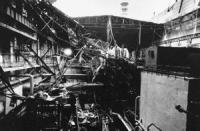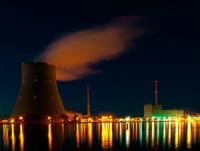-
Remotely monitoring nuclear reactors
A new U.S. Department of Energy project to develop the first detector able to remotely monitor nuclear reactors will also help physicists test the next generation of neutrino observatories. Nuclear reactions produce telltale antineutrinos – the antimatter counterpart of neutrinos. The new detectors will be designed to measure the energy of such antineutrinos and the direction from which they come, allowing monitoring of reactors from a distance of 25 kilometers to verify nonproliferation agreements.
-
-
Efficient extraction may improve management of nuclear fuel
After used nuclear fuel is removed from a reactor, it emits heat for decades and remains radioactive for thousands of years. The used fuel is a mixture of major actinides (uranium, plutonium), fission products (mainly assorted metals, including lanthanides) and minor actinides (i.e., americium, curium and neptunium). After the cesium-137 and strontium-90 fission products decay in a few hundred years, the minor actinides and plutonium generate the most heat and radioactivity. Removal of the minor actinides, especially americium, can help nuclear power producers reduce and better manage the waste stream.
-
-
Sandia transport triathlon puts spent nuclear fuel to the test
Nuclear power supplies almost 20 percent of U.S. electricity and is the leading carbon-neutral power source. However, it produces between 2,200 and 2,600 tons of spent fuel in the United States each year. Fuel rods become brittle and highly radioactive while powering the nuclear reactor, making safe transportation important. Sandia National Laboratories researchers completed an eight-month, 14,500-mile triathlon-like test to gather data on the bumps and jolts spent nuclear fuel experiences during transportation.
-
-
Pipe-crawling robot to help decommission DOE nuclear facility
A pair of autonomous robots developed by Carnegie Mellon University’s Robotics Institute will soon be driving through miles of pipes at the U.S. Department of Energy’s former uranium enrichment plant in Piketon, Ohio, to identify uranium deposits on pipe walls. The CMU robot has demonstrated it can measure radiation levels more accurately from inside the pipe than is possible with external techniques.
-
-
New evidence of nuclear fuel releases discovered at Fukushima
Uranium and other radioactive materials, such as cesium and technetium, have been found in tiny particles released from the damaged Fukushima Daiichi nuclear reactors. This could mean the environmental impact from the fallout may last much longer than previously expected according to a new study by a team of international researchers. The team says that, for the first time, the fallout of Fukushima Daiichi nuclear reactor fuel debris into the surrounding environment has been “explicitly revealed” by the study.
-
-
Before the U.S. approves new uranium mining, consider its toxic legacy
Uranium – the raw material for nuclear power and nuclear weapons – is having a moment in the spotlight. Companies such as Energy Fuels, Inc. have played well-publicized roles in lobbying the Trump administration to reduce federal protection for public lands with uranium deposits. The Defense Department’s Nuclear Posture Review calls for new weapons production to expand the U.S. nuclear arsenal, which could spur new domestic uranium mining. And the Interior Department is advocating more domestic uranium production, along with other materials identified as “critical minerals.” I have studied the legacies of past uranium mining and milling in Western states for over a decade. My book examines dilemmas faced by uranium communities caught between harmful legacies of previous mining booms and the potential promise of new economic development. These people and places are invisible to most Americans, but they helped make the United States an economic and military superpower. In my view, we owe it to them to learn from past mistakes and make more informed and sustainable decisions about possibly renewing uranium production than our nation made in the past.
-
-
Thorium reactors could dispose of large amounts of weapons-grade plutonium
Scientists are developing a technology enabling the construction of high-temperature, gas-cool, low-power reactors with thorium fuel. The scientists propose to burn weapons-grade plutonium in these units, converting it into power and thermal energy. Thermal energy generated at thorium reactors may be used in hydrogen industrial production. The technology also makes it possible to desalinate water.
-
-
FAA declares seven nuclear research facilities no-drone zones
The Federal Aviation Administration (FAA) has granted a request from the Department of Energy (DOE) to declare seven DOE’s nuclear research facilities no-drone zones. Starting 29 December, drone operators would not be allowed to fly their UAVs within 400 feet of these facilities: The FAA said it is currently considering more “no-drone zone” requests from federal agencies.
-
-
Evacuating a nuclear disaster area is often a waste of time and money, says study
Over 110,000 people were moved from their homes following the Fukushima nuclear disaster in Japan in March 2011. Another 50,000 left of their own will, and 85,000 had still not returned four-and-a-half years later. While this might seem like an obvious way of keeping people safe, my colleagues and I have just completed research that shows this kind of mass evacuation is unnecessary, and can even do more harm than good. We calculated that the Fukushima evacuation extended the population’s average life expectancy by less than three months. The reality is that, in most cases, the risk from radiation exposure if tpeople stay in their homes is minimal. It is important that the precedents of Chernobyl and Fukushima do not establish mass relocation as the prime policy choice in the future, because this will benefit nobody.
-
-
Radioactive material, leaked from a Russian nuclear complex, detected over Europe
The Russian state meteorological agency Roshydromet today released data which show exceedingly high atmospheric concentration of ruthenium-106 in the area where the Rosatom Mayak nuclear complex, located in the Southern Urals. The late-September leak, initially denied by Roasatom, the operator of the complex, caused the radioactive material to spread over northern Europe, where it was detected by IRSN and BfS, the French and German nuclear safety agencies, respectively.
-
-
New theory of the opening moments of Chernobyl disaster

Researchers, relying on new evidence and analysis, have come up with a new theory of the opening moments during the Chernobyl disaster, the most severe nuclear accident in history. The new theory suggests the first of the two explosions reported by eyewitnesses was a nuclear and not a steam explosion, as is currently widely thought.
-
-
Nuclear energy programs do not increase likelihood of nuclear weapons proliferation: Study

Contrary to popular thought, nuclear proliferation is not more likely to occur among countries with nuclear energy programs, according to new research. In a historical analysis of the relationship between nuclear energy programs and proliferation from 1954 to 2000, the study finds that the link between the two has been overstated. “The findings suggest that international efforts to manage the proliferation risks of nuclear energy programs have been quite effective,” says the study’s author. “Even when countries become more technically capable of developing nuclear weapons due to an energy program, they can often be restrained by timely intelligence and the prospect of sanctions.”
-
-
U.S. advanced nuclear program unlikely to deliver on its mission
Despite repeated promises over the past eighteen years, the U.S. Office of Nuclear Energy (NE) is unlikely to deliver on its mission to develop and demonstrate an advanced nuclear reactor by the mid-twenty-first century. That is the conclusion of a new study which used data obtained through the Freedom of Information Act to reconstruct the program’s budget history.
-
-
Why the withering nuclear power industry threatens U.S. national security
These are tough times for nuclear power in the United States. Power plants under construction are facing serious delays, halts and cost overruns. Utilities in South Carolina abandoned a project to complete construction of two power plants in August, while the cost of the only nuclear plant now under construction has ballooned to $25 billion. While the environmental and reliability impacts of the closures are well-understood, what many don’t realize is that these closures also pose long-term risks to our national security. As the nuclear power industry declines, it discourages the development of our most important anti-proliferation asset: a bunch of smart nuclear scientists and engineers. There are already strong economic, reliability and environmental reasons to keep nuclear a part of the national fuel mix. Enhancing our national security makes the argument even more compelling.
-
-
Decommissioning aging nuclear reactors
Since the dawn of the nuclear era seventy-five years ago, the Argonne National Laboratory (ANL) has helped develop nuclear power for peaceful purposes. Today, commercial nuclear reactors supply nearly 20 percent of U.S. electricity. Now, ANL’s Decontamination and Decommissioning (D&D) Program is helping in decommissioning aging nuclear facilities.
-
- All
- Regional
- Water
- Biometrics
- Borders/Immig
- Business
- Cybersecurity
- Detection
- Disasters
- Government
- Infrastructure
- International
- Public health
- Public Safety
- Communication interoperabillity
- Emergency services
- Emergency medical services
- Fire
- First response
- IEDs
- Law Enforcement
- Law Enforcement Technology
- Military technology
- Nonlethal weapons
- Nuclear weapons
- Personal protection equipment
- Police
- Notification /alert systems
- Situational awareness
- Weapons systems
- Sci-Tech
- Sector Reports
- Surveillance
- Transportation
Advertising & Marketing: advertise@newswirepubs.com
Editorial: editor@newswirepubs.com
General: info@newswirepubs.com
2010-2011 © News Wire Publications, LLC News Wire Publications, LLC
220 Old Country Road | Suite 200 | Mineola | New York | 11501
Permissions and Policies
Editorial: editor@newswirepubs.com
General: info@newswirepubs.com
2010-2011 © News Wire Publications, LLC News Wire Publications, LLC
220 Old Country Road | Suite 200 | Mineola | New York | 11501
Permissions and Policies
